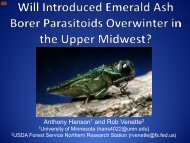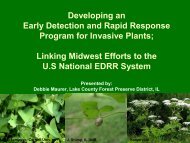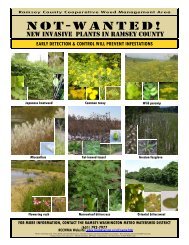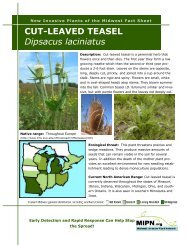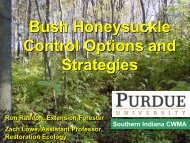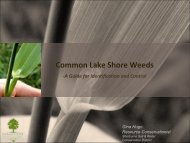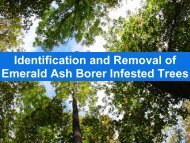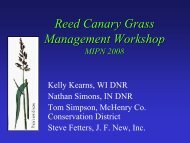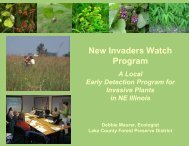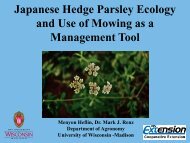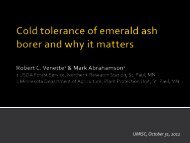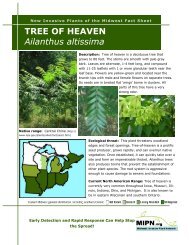CHINESE YAM Dioscorea oppositifolia - Midwest Invasive Plant ...
CHINESE YAM Dioscorea oppositifolia - Midwest Invasive Plant ...
CHINESE YAM Dioscorea oppositifolia - Midwest Invasive Plant ...
Create successful ePaper yourself
Turn your PDF publications into a flip-book with our unique Google optimized e-Paper software.
New <strong>Invasive</strong> <strong>Plant</strong>s of the <strong>Midwest</strong> Fact Sheet<strong>CHINESE</strong> <strong>YAM</strong><strong>Dioscorea</strong> <strong>oppositifolia</strong>Description: Chinese Yam is a herbaceous,perennial vine that twines clockwiseand can climb up to 15 feet.Leaves are opposite with the uppernodes alternate, and are reddish wherethe leaf stem joins the leaf. They waryin shape, but are often shield– or heartshaped.Flowers are small and white,arranged in spikes, and have a cinnamon odor. Reproductivebulbils (small potato-like tubers in leaf axils) are present fromJunethroughSeptember.Native range: Throughout China (http://www.invasive.org/eastern/eppc/DIOP.html)Ecological threat: This plant threatens stream sides,floodplains, and ravines. It can tolerate semi-xeric siteswith rocky soils. It grows in full sun and can tolerate allbut the deepest shade.Current North American Range: Chinese Yam is currentlyobserved throughout Indiana and in the southernhalves of Missouri, Illinois, and Ohio.Early Detection and Rapid Response Can Help Stopthe Spread!
<strong>CHINESE</strong> <strong>YAM</strong>, <strong>Dioscorea</strong> <strong>oppositifolia</strong>MANAGEMENT OPTIONS: (http://www.invasive.org/eastern/eppc/DIOP.html)Mechanical ControlMowing/Cutting: This method is appropriate for small initial populations or environmentally sensitiveareas where herbicides cannot be used. Mowing or cutting will control the spread of Chinese yam,but will not eradicate it unless it is continued for several growing seasons or until the root reservesare exhausted. Stems should be cut at least once per growing season as close to ground level aspossible. Treatment should be completed prior to bulbil production typically in July.Grubbing: This method is appropriate for small initial populations or environmentally sensitive areaswhere herbicides cannot be used. Using a pulaski or similar digging tool, remove the entire plant,including all roots and bulbils (if present). Juvenile plants can be hand pulled depending on soil conditionsand root development. Any portions of the root system not removed will potentially resprout.Mulching: Mulching is an effective control on small infestations or in areas where herbicides cannotbe used. Cover the entire infestation with several inches of mulch. This may include wood chips,grass clippings, hay or similar degradable plant material. Shredded or chipped wood may be the bestoption since hay and grass may potentially carry weed seeds. Covering the area with cardboard mayimprove the effectiveness and longevity of this method. The mulch should stay in place for at leasttwo growing season and may need to be augmented several times.Herbicidal ControlFoliar Spray Method: Use this method to control large populations. The most effective time to treatplants is after the leaves are fully expanded but before the aerial tubers are ripe.Glyphosate: Apply a 4% solution of glyphosate and water plus 0.5%-1% non-ionic surfactant tothoroughly wet all foliage. Do not apply so heavily that herbicide will drip off leaves. Glyphosate is anon-selective systemic herbicide that may kill non-target partially sprayed plants. Ambient air temperatureshould be above 65°F.Triclopyr: If native grasses are intermingled with the Chinese yam, triclopyr is preferred since it isselective to broadleaved plants. Apply a 4% solution of triclopyr and water to thoroughly wet all foliage.Do not apply so heavily that herbicide will drip off leaves. A 0.5%-1% non-ionic surfactant isrecommended in order to penetrate the leaf cuticle, and ambient air temperature should be above65°F.For more information on control and management of this species, please visit the followingWeb sites: www.usda.plants.gov, www.nps.gov/plants/alien/factmain.htm,tncweeds.ucdavis.edu/comtrol.html, dnr.wi.gov/invasives/plants.htm, www.invasivespeciesinfo.gov/plants/main.shtml, http://www.nps.gov/plants/alien/fact/pope1.htmEarly Detection and Rapid Response Can Help Stop theSpread!





